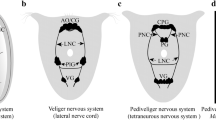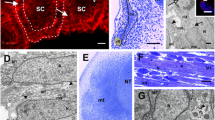Abstract
Recent interpretations of developmental gene expression patterns propose that the last common metazoan ancestor was segmented, although most animal phyla show no obvious signs of segmentation. Developmental studies of non-model system trochozoan taxa may shed light on this hypothesis by assessing possible cryptic segmentation patterns. In this paper, we present the first immunocytochemical data on the ontogeny of the nervous system and the musculature in the sipunculan Phascolion strombus. Myogenesis of the first anlagen of the body wall ring muscles occurs synchronously and not subsequently from anterior to posterior as in segmented spiralian taxa (i.e. annelids). The number of ring muscles remains constant during the initial stages of body axis elongation. In the anterior-posteriorly elongated larva, newly formed ring muscles originate along the entire body axis between existing myocytes, indicating that repeated muscle bands do not form from a posterior growth zone. During neurogenesis, the Phascolion larva expresses a non-metameric, paired, ventral nerve cord that fuses in the mid-body region in the late-stage elongated larva. Contrary to other trochozoans, Phascolion lacks any larval serotonergic structures. However, two to three FMRFamide-positive cells are found in the apical organ. In addition, late larvae show commissure-like neurones interconnecting the two ventral nerve cords, while early juveniles exhibit a third, medially placed FMRFamidergic ventral nerve. Although we did not find any indications for cryptic segmentation, certain neuro-developmental traits in Phascolion resemble the conditions found in polychaetes (including echiurans) and myzostomids and support a close relationship of Sipuncula and Annelida.





Similar content being viewed by others
References
Abouheif E, Akam M, Dickinson WJ, Holland PWJ, Meyer A, Patel NH, Raff RA, Roth VL, Wray G (1997) Homology and developmental genes. Trends Genet 13:432–433
Aguinaldo AMA, Turbeville JM, Linford LS, Rivera MC, Garey JR, Raff RA, Lake JA (1997) Evidence for a clade of nematodes, arthropods and other moulting animals. Nature 387:489–493
Åkesson B (1958) A study of the nervous system of the Sipunculoideae with some remarks on the development of the two species Phascolion strombi Montagu and Golfingia minuta Keferstein. Undersökningar över Öresund 38:1–249
Balavoine G, Adoutte A (2003) The segmented Urbilateria: a testable scenario. Integr Comp Biol 43:137–147
Bleidorn C, Vogt L, Bartolomaeus T (2003a) A contribution to sedentary polychaete phylogeny using 18S rRNA sequence data. J Zoolog Syst Evol Res 41:186–195
Bleidorn C, Vogt L, Bartolomaeus T (2003b) New insights into polychaete phylogeny (Annelida) inferred from 18S rDNA sequences. Mol Phylogenet Evol 29:279–288
Boore JL (2004) Complete mitochondrial genome sequence of Urechis caupo, a representative of the phylum Echiura. BMC Genomics 5:67
Boore JL, Staton JL (2002) The mitochondrial genome of the sipunculid Phascolopsis gouldii supports its association with Annelida rather than Mollusca. Mol Biol Evol 19:127–137
Davis GK, Patel NH (1999) The origin and evolution of segmentation. Trends Cell Biol 9:M68–M72
Dickinson AJG, Nason J, Croll RP (1999) Histochemical localization of FMRFamide, serotonin and catecholamines in embryonic Crepidula fornicata (Gastropoda, Prosobranchia). Zoomorphology 119:49–62
Eeckhaut I, Fievez L, Müller MCM (2003) Larval development of Myzostoma cirriferum. J Morphol 258:269–283
Eernisse DJ, Albert JS, Anderson FE (1992) Annelida and Arthropoda are not sister taxa: a phylogenetic analysis of spiralian metazoan morphology. Syst Biol 41:305–330
Friedrich S, Wanninger A, Brückner M, Haszprunar G (2002) Neurogenesis in the mossy chiton, Mopalia muscosa (Gould) (Polyplacophora): evidence against molluscan metamerism. J Morphol 253:109–117
Giribet G, Distel DL, Polz M, Sterrer W, Wheeler WC (2000) Triploblastic relationships with emphasis on the acoelomates and the position of Gnathostomulida, Cycliophora, Platyhelminthes, and Chaetognatha: a combined approach of 18S rDNA sequences and morphology. Syst Biol 49:539–562
Halanych KM, Bacheller JD, Aguinaldo AMA, Liva SM, Hillis DM, Lake JA (1995) Evidence from 18S ribosomal DNA that the lophophorates are protostome animals. Science 267:1641–1643
Hall JR, Scheltema RS (1975) Comparative morphology of open-ocean pelagosphera. In: Rice ME, Todorovic M (eds) Proceedings of the international symposium on the biology of the Sipuncula and Echiura, vol 1. Naucno Delo, Belgrade, pp 183–197
Haszprunar G, Schaefer K (1997) Anatomy and phylogenetic significance of Micropilina arntzi (Mollusca, Monoplacophora, Micropilinidae fam. nov.). Acta Zool 77:315–334
Haszprunar G, Wanninger A (2000) Molluscan muscle systems in development and evolution. J Zoolog Syst Evol Res 38:157–163
Hay-Schmidt A (1990) Catecholamine-containing, serotonin-like and neuropeptide FMRFamide-like immunoreactive cells and processes of the nervous system of the pilidium larva (Nemertini). Zoomorphology 109:231–244
Hay-Schmidt A (2000) The evolution of the serotonergic nervous system. Proc R Soc Lond B 267:1071–1079
Hessling R (2002) Metameric organisation of the nervous system in developmental stages of Urechis caupo (Echiura) and its phylogenetic implications. Zoomorphology 121:221–234
Hessling R (2003) Novel aspects of the nervous system of Bonellia viridis (Echiura) revealed by the combination of immunohistochemistry, confocal laser-scanning microscopy and three-dimensional reconstruction. Hydrobiologia 496:225–239
Hessling R, Westheide W (2002) Are Echiura derived from a segmented ancestor?—immunohistochemical analysis of the nervous system in developmental stages of Bonellia viridis. J Morphol 252:100–113
Hill SD, Boyer BC (2001) Phalloidin labeling of developing muscle in embryos of the polychaete Capitella sp. I. Biol Bull 201:257–258
Holland ND (2003) Early central nervous system evolution: an era of skin brains? Nat Rev Neurosci 4:617–627
Ierusalimsky VN, Zakharov IS, Balaban PM (1997) Comparison of serotonin and dopamine neural systems in adult and juvenile terrestrial snails Helix and Eobania. Zh Vyssh Nerv Deiat Im I P Pavlova 47:563–576
Jaeckle WB, Rice ME (2002) Phylum Sipuncula. In: Young CM (ed) Atlas of marine invertebrate larvae. Academic, London, pp 375–396
Jenner RA (2001) Bilaterian phylogeny and uncritical recycling of morphological data sets. Syst Biol 50:730–742
Jenner RA (2003) Unleashing the force of cladistics? Metazoan phylogenetics and hypothesis testing. Integr Comp Biol 43:207–218
Jennings RM, Halanych KM (2005) Mitochondrial genomes of Clymenella torquata (Maldanidae) and Riftia pachyptila (Siboglinidae): evidence for conserved gene order in Annelida. Mol Biol Evol 22:210–222
Jördens J, Struck T, Purschke G (2004) Phylogenetic inference regarding Parergodrilidae and Hrabeiella periglandulata (“Polychaeta”, Annelida) based on 18S rDNA, 28S rDNA and COI sequences. J Zoolog Syst Evol Res 42:270–280
Lacalli TC, West JE (1985) The nervous system of a pilidium larva: evidence from electron-microscope reconstructions. Can J Zool 63:1909–1916
Ladurner P, Rieger R (2000) Embryonic muscle development of Convolutra pulchra (Turbellaria–Acoelomorpha, Platyhelminthes). Dev Biol 222:359–375
Maslakova SA, Martindale MQ, Norenburg JL (2004) Vestigial prototroch in a basal nemertean Carinoma tremaphorus (Nemertea, Palaeonemertea). Evol Dev 6:219–226
McHugh D (1997) Molecular evidence that echiurans and pogonophorans are derived annelids. Proc Natl Acad Sci U S A 94:8006–8009
McHugh D (2000) Molecular phylogeny of the Annelida. Can J Zool 78:1873–1884
Müller MCM, Westheide W (1997) Das Nervensystem parapodienloser Polychaeten: orthogonale Strukturen des Nervensystems juveniler Stadien und progenetischer Arten. Verh Dtsch Zool Ges 90:209
Müller MCM, Westheide W (2000) Structure of the nervous system of Myzostoma cirriferum (Annelida) as revealed by immunohistochemistry and cLSM analyses. J Morphol 245:87–98
Müller MCM, Westheide W (2002) Comparative analysis of the nervous systems in presumptive progenetic dinophilid and dorvilleid polychaetes (Annelida) by immunohistochemistry and cLSM. Acta Zool 83:33–48
Nielsen C (2004) Trochophora larvae: cell lineages, ciliary bands, and body regions. 1. Annelida and Mollusca. J Exp Zoolog Mol Dev Evol 302B:35–68
Payton B (1981) Structure of the leech nervous system. In: Muller KJ, Nicholls JG, Stent GS (eds) Neurobiology of the leech. Cold Spring Harbor Laboratory, New York, pp 35–50
Prud'homme B, de Rosa R, Arendt D, Julien J-F, Pajaziti R, Dorresteijn AWC, Adoutte A, Wittbrodt J, Balavoine G (2003) Arthropod-like expression patterns of engrailed and wingless in the annelid Platynereis dumerilii suggest a role in segment formation. Curr Biol 13:1876–1881
Rice ME (1973) Morphology, behaviour and histogenesis of the pelagosphera larva of Phascolosoma agassizii (Sipuncula). Smithson Contrib Zool 132:1–51
Rice ME (1985) Sipuncula: developmental evidence for phylogenetic inference. In: Conway Morris S, George JD, Gibson R, Platt HM (eds) The origins and relationships of lower invertebrates. Clarendon, Oxford, pp 274–296
Scheltema AH (1993) Aplacophora as progenetic aculiferans and the coelomate origin of mollusks as the sister taxon of Sipuncula. Biol Bull 184:57–78
Schulze A, Rice ME (2003) Muscle development in larvae and juveniles of four sipunculan species. Integr Comp Biol 43:936
Seaver EC (2003) Segmentation: mono- or polyphyletic? Int J Dev Biol 47:538–595
Siddall ME, Fitzhugh K, Coates KA (1998) Problems determining the phylogenetic position of echiurans and pogonophorans with limited data. Cladistics 14:401–410
Staton JL (2003) Phylogenetic analysis of the mitochondrial cytochrome c oxidase subunit 1 gene from 13 sipunculan genera: intra- and interphylum relationships. Invertebr Biol 122:252–264
Voronezhskaya EE, Tyurin SA, Nezlin LP (2002) Neuronal development in larval chiton Ischnochiton hakodadensis (Mollusca: Polyplacophora). J Comp Neurol 444:25–38
Voronezhskaya EE, Tsitrin EB, Nezlin LP (2003) Neuronal development in larval polychaete Phyllodoce maculata (Phyllodocidae). J Comp Neurol 455:299–309
Wanninger A, Haszprunar G (2002a) Chiton myogenesis: perspectives for the development and evolution of larval and adult muscle systems in molluscs. J Morphol 251:103–113
Wanninger A, Haszprunar G (2002b) Muscle development in Antalis entalis (Mollusca, Scaphopoda) and its significance for scaphopod relationships. J Morphol 254:53–64
Wanninger A, Haszprunar G (2003) The development of the serotonergic and FMRF-amidergic nervous system in Antalis entalis (Mollusca, Scaphopoda). Zoomorphology 122:77–85
Wanninger A, Ruthensteiner B, Lobenwein S, Salvenmoser W, Dictus WJAG, Haszprunar G (1999) Development of the musculature in the limpet Patella (Mollusca, Patellogastropoda). Dev Genes Evol 209:226–238
Witten JL, Truman JW (1996) Developmental plasticity of neuropeptide expression in motoneurons of the moth, Manduca sexta: steroid hormone regulation. J Neurobiol 29:99–114
Acknowledgements
The authors are indebted to Michael Thorndyke and the staff of the Kristineberg Marine Research Station (Sweden) and the Heron Island Research Station (Australia) for their hospitality and support throughout the years. We thank Olga Alexandrova and Charles N. David (Munich) for making confocal microscopy available. We are particularly grateful to Mark Q. Martindale (Hawaii) and three anonymous reviewers whose detailed criticisms greatly improved the manuscript. The financial support of the German Science Foundation (DFG) (grant WA 1580/1–2 to AW), the European Commission (ARI-programme, 5th framework, to AW), and the Australian Research Council (to BD) are gratefully acknowledged.
Author information
Authors and Affiliations
Corresponding author
Additional information
Communicated by M.Q. Martindale
Rights and permissions
About this article
Cite this article
Wanninger, A., Koop, D., Bromham, L. et al. Nervous and muscle system development in Phascolion strombus (Sipuncula). Dev Genes Evol 215, 509–518 (2005). https://doi.org/10.1007/s00427-005-0012-0
Received:
Accepted:
Published:
Issue Date:
DOI: https://doi.org/10.1007/s00427-005-0012-0




